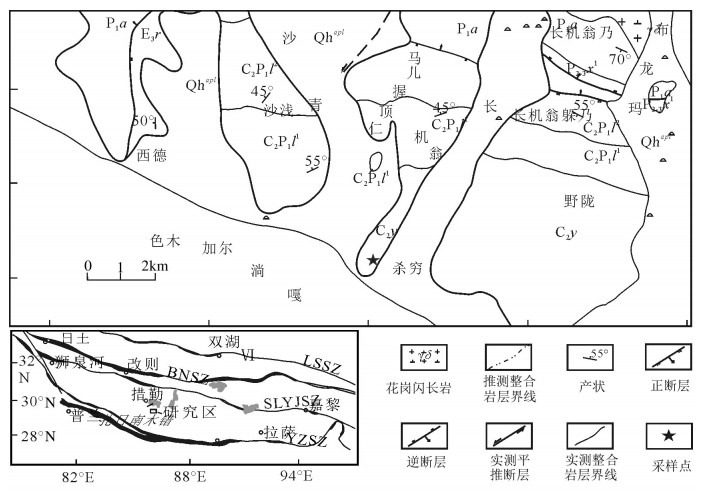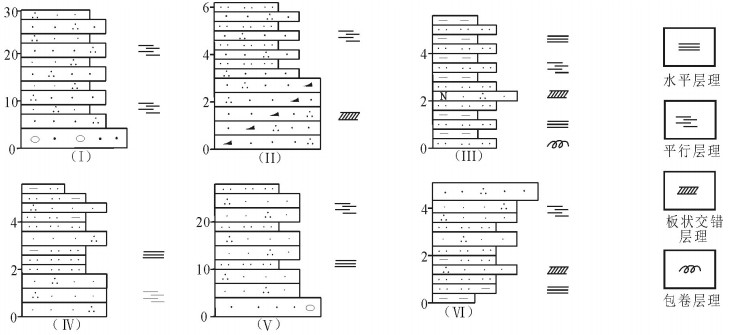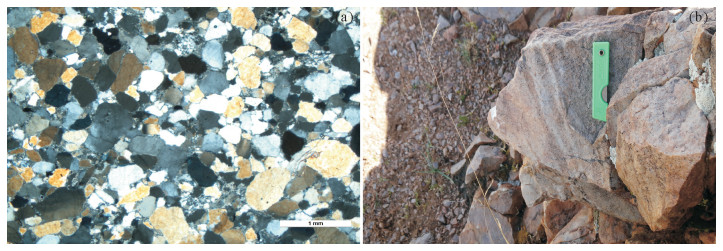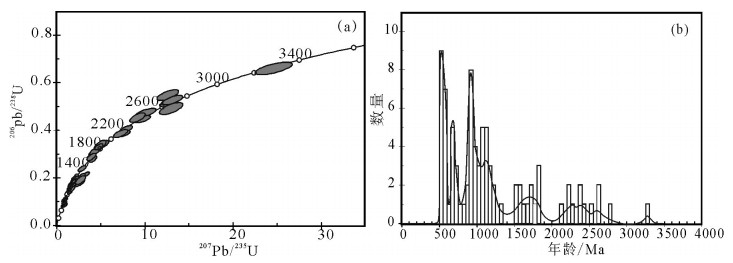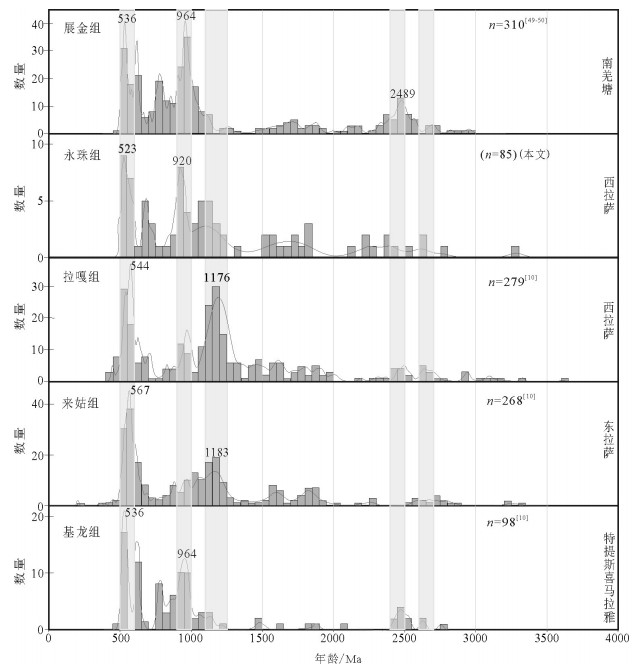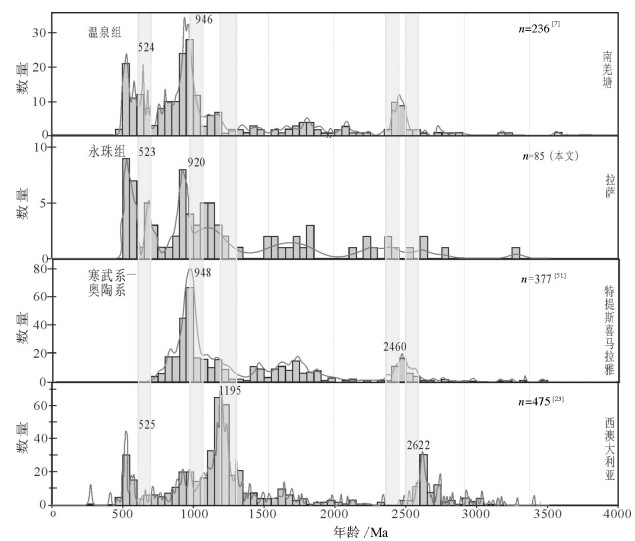Evolution of Late Paleozoic sedimentary provenance of Lhasa block: Detrital zircons from Yongzhu Formation in Cuoqin area, Tibet
-
摘要:
晚古生代是拉萨地块地质演化的重要转折期,一些关键地质问题存在争论,如拉萨地块来源问题。选择西藏措勤地区上石炭统永珠组为研究对象,石英砂岩中碎屑锆石U-Pb测年数据显示523Ma、920Ma两个年龄峰值。通过与拉萨地块及其周缘晚石炭世冰期之前地层碎屑锆石对比,认为拉萨地块永珠组920Ma年龄峰值更具有冈瓦纳大陆靠印度一侧的物源特征,其与南羌塘、拉萨、喜马拉雅微陆块在裂离之前具有显著的亲缘关系。而含有冰筏碎屑的拉嘎组和来姑组中包含的西澳大利亚物源信息(约1180Ma年龄峰值),暗示来自西澳大利亚的冰筏可能通过洋流作用漂移至拉萨地块而后沉积冰筏碎屑。
Abstract:The Late Paleozoic is an important transition period for the geological evolution of the Lhasa block, so there are some disputes on key geological issues, such as the origin of the Lhasa block. In this paper, the Upper Carboniferous Yongzhu Formation in the Cuoqin region of Tibet was selected as the study object. The U-Pb dating data of detrital zircons in quartz sandstone show the peak ages of 523Ma and 920Ma. Based on a comparison with the Lhasa block and the detrital zircons formed before the Lhasa blockin the Late Carboniferous glacial period, the authors hold that the 920Ma agepeak of the Yongzhu Formation in the Lhasa block is more characteristic of the provenance on the Indian side of the Gondwana opening, and that the Nanqiangtang, Lhasa and Himalayan microlandmasses were significantly related before splitting. The source information of western Australia (about 1180Ma age peak) in the Laga and Laigu groups containing ice raft debris suggests that ice rafts from western Australia might have drifted to the Lhasa block through ocean currents and then deposited ice raft debris.
-
Keywords:
- Gondwana continent /
- Lhasa block /
- Yongzhu Formation /
- Laga Formation /
- detrital zircon
-
IOCG型矿床,即铁氧化物-铜-金矿床,指铁氧化物含量大于20%的铜-金矿床,主要分布在澳大利亚、巴西、智利、加拿大、美国、南非等国及中国内蒙古、海南、四川、长江中下游等地。其一般具有规模大、品位高、元素多、埋藏浅、易采选等特点,是近年来颇受国内外矿业界、勘查界、矿床界等地质领域重视的一种矿床组合类型[1-7]。由于IOCG型矿床富含铁氧化物,常缺失硫化物,且蚀变范围广阔,地球物理特征明显(成矿区的磁场和重力效应明显,具有重力高、中-高幅磁异常为标志)。因此,高精度磁测往往是寻找IOCG矿床重要的有效手段之一。
对于磁测数据的处理和解译是找矿预测的重要环节。其中RGIS是中国地质调查局发展研究中心牵头研发的物探重磁电数据处理与解释软件系统。与国内外重磁专业数据处理软件相比,RGIS系统具有重磁数据整理齐备、规范,数据预处理功能丰富,重磁数据处理功能全面、实用,数据范围和格式广泛,输入输出方便、快捷、规范等特点。目前已成为中国用户最多、覆盖面最广、产学研多方应用率最高的物探专业软件,在各类地质矿产和油气勘查与评价工作中发挥着重要作用[8-22]。
为探讨高精度磁测在IOCG型铁矿勘查中的应用效果,本文以智利英格瓦塞铁矿为例,在矿区1:5000地面高精度磁测基础上,利用RGIS软件重点针对中部矿区的磁测数据,进行面积上延、面积下延、精测剖面下延及2.5D反演拟合处理,初步确定了矿体的空间分布,为后期地质找矿勘探工作奠定了很好的基础。同时,通过初步对比海南石碌铁矿,发现IOCG型铁矿皆具有富含铁氧化物的特征,磁场特征明显,因而该方法也可进一步推广应用于中国IOCG型铁矿勘查。
1. 区域地质背景
智利英格瓦塞铁矿位于美洲大陆西缘安第斯褶皱山系南美褶皱带构造区内中生代格拉岛弧弧前盆地。区域出露地层主要为中生界上三叠统—下侏罗统水之歌组、下白垩统大十二弦琴组和查尼拉尔组、上白垩统塞里约斯组、新生界古近系—新近系和第四系。区域构造主要由褶皱和断层构成。其中褶皱主要分布在区域西北部;区域内断裂构造相对发育,主要为SN向断层(区域阿塔卡玛断裂近SN向贯穿本区),其次为NE向、NW向断层。区域内岩浆活动强烈,主要为燕山期中酸性侵入体,岩体贯穿区域南北,规模巨大,呈岩基产出,出露面积占区域面积30%以上。区域内矿产资源丰富,主要矿种为铜、金、铁。铁氧化物铜金型(IOCG)矿床分布广泛(图 1)。
![]() 图 1 智利英格瓦塞铁矿中部矿区地质图(区域位置图据参考文献[1]修改)Figure 1. Geological map of the central mining area of the Incaguasi iron deposit in Chile
图 1 智利英格瓦塞铁矿中部矿区地质图(区域位置图据参考文献[1]修改)Figure 1. Geological map of the central mining area of the Incaguasi iron deposit in Chile2. 矿区地质特征
智利英格瓦塞铁矿属于IOCG型矿床,由中部、北部、西南部3个矿区构成,中部矿区是其主要部分,位于智利阿塔卡玛大区巴耶纳尔市英格瓦塞镇北西约1.5 km处,隶属英格瓦塞镇管辖。
矿区地层出露主要为中生界下白垩统大十二弦琴组(其岩性为安山岩)和第四系(冲积物)。矿区地层总体为一单斜构造,走向NE,倾向SE,倾角约为16°,局部有扭曲现象,产状略有变化。由于本区工作程度尚低,未见明显的断裂等构造。区内岩浆岩极发育,主要发育花岗闪长岩岩体、花岗斑岩岩脉及辉石角闪石岩岩体。其中,区内广泛发育花岗闪长岩,其侵入大十二弦琴组中,使地层出露分布较凌乱,同时亦侵入辉石角闪石岩岩体中,野外可见辉石角闪石岩岩体以捕虏体形式赋存于花岗闪长岩岩体中,两者之间界线清晰。辉石角闪石岩主要分布在矿区中部,局部根据含磁铁矿异同,可分为含磁铁辉石角闪石岩、磁铁角闪石岩、角闪磁铁岩。花岗斑岩岩脉主要分布在中部矿区的东北部,总体呈NW向产出,侵入于花岗闪长岩及含磁铁角闪石岩中。此外还出露少量正长岩,呈岩株产出(图 1)。
矿区目前发现4条规模较大的矿体,主要产于含磁铁辉石角闪石岩中,围岩基本为花岗闪长岩。矿体总体呈带状,走向NE,倾向NW,倾角较陡,多70°~90°,单个矿体长约几百米至上千米,宽约几十米至上百米。矿石类型可分为含磁铁辉石角闪石岩、磁铁角闪石岩,含角闪磁铁岩。矿石主要为细粒结构,块状构造。矿石矿物成分较简单,主要为磁铁矿,其次为赤铁矿,局部见孔雀石、蓝铜矿。脉石矿物以角闪、辉石为主。地表浅部围岩矿化与蚀变主要有褐铁矿化、磁铁矿化、赤铁矿化、镜铁矿化、孔雀石化、蓝铜矿化(多在岩石裂隙面发育)、高岭土化、绿泥石化等。
3. 中部矿区磁异常特征
从区域物性参数K(磁化率,单位为4π×10-6SI)和Jr(剩磁强度,单位为10-3A/m)可知,本区花岗闪长岩磁性一般为K=37.5~3046,Jr=14.74~350;花岗斑岩磁性一般为K=23.46~3792,Jr=12.24~228;磁铁角闪石岩为K=2000~120000,Jr=2000~160000;正长斑岩K=0.41~2000,Jr=0.01~30;安山岩K=5~3000,Jr=5~400;含磁铁辉石角闪石岩一般为K=10~10000,Jr=10~3000;辉石角闪石岩一般为K=0.1~1000,Jr=0.1~400。磁性最强的为磁铁角闪石岩,其次为含磁铁辉石角闪石岩,与围岩有明显的磁性差异,因此,本区采用磁法手段勘查非常有效。
根据1:5000地面高精度磁测ΔT等值线图,结合本地区地质及岩石磁性特征,有意义的异常区圈定为大于或等于1600 nT。该工区内的ΔT最大值为5173.3 nT,等值线总体呈NE向延伸。该磁异常区内含7个大于1600 nT的规模较大的磁异常圈,编号分别为Ⅰ、Ⅱ、Ⅲ、Ⅳ、Ⅴ、Ⅵ、Ⅶ(图 2)。
Ⅰ号磁异常位于中部矿区的北部,异常中心ΔT最大值为3273.1 nT。该磁异常呈不规则椭圆状,长轴呈NE向,长321 m,短轴最大宽度123 m,规模为40936 m2。该磁异常东南翼等值线较密,梯度变化较大,北西翼梯度变化较小,定性判断引起该磁异常的磁性地质体呈NE走向、向NW向倾斜。
Ⅱ号磁异常位于Ⅰ号磁异常的西南部,异常中心ΔT最大值为2229.3 nT。该磁异常呈不规则椭圆状,长轴呈EW向,长轴长340 m,短轴最大宽度为97 m,规模为39856 m2。该磁异常两翼较对称,初步认定引起该磁异常的磁性地质体呈EW走向、倾角较直立。
Ⅲ号磁异常位于矿区的中西部,异常中心ΔT最大值为2423.8 nT。该异常未完全封闭,长轴呈NE向,长轴长500 m,短轴最大宽度180 m,规模为98163 m2。该异常两翼较对称,初步认定引起该磁异常的磁性地质体呈NE走向、倾角较直立。
Ⅳ号磁异常位于Ⅲ号磁异常的南部,异常中心ΔT最大值为2814.6 nT。该磁异常呈不规则长圆状,长轴呈NE向,长370 m,短轴最大宽度120 m,规模为53993 m2。该磁异常南部为负异常且梯度变化大,初步判定引起该磁异常的磁性地质体呈NE走向、向NW倾斜。
Ⅴ号磁异常位于矿区的南部,异常中心ΔT最大值为2511.3 nT。该异常呈不规则长圆状,长轴呈NE向,长190 m,短轴最大宽度64 m,规模为14396 m2。该磁异常两翼较对称,初步认定引起该磁异常的磁性地质体呈NE走向、倾角较直立。
Ⅵ号磁异常位于矿区的东南部,异常中心ΔT最大值为4339.6 nT。该磁异常呈不规则椭圆状,长轴呈NE向,长660 m,短轴最大宽度170 m,规模为75645 m2。该磁异常南部为负异常且梯度变化大,初步判定引起该磁异常的磁性地质体呈NE走向、向NW倾斜。
Ⅶ号磁异常位于矿区的东北部,异常中心ΔT最大值为5173.3 nT。该磁异常呈椭圆状,长轴呈NE向,长300 m,短轴最大宽度130 m,规模为34740 m2。该磁异常西南翼等值线较密,梯度变化较大,东北部梯度变化较小,初步判定引起该磁异常的磁性地质体呈NE走向、向NW倾斜。
4. 中部矿区磁异常解释
磁异常是各种不同性质、不同深度、不同形态、不同规模的磁性体磁场叠加在一起反应的结果。但是在原始图件上很难识别,给地质解释及验证工作带来了难度。为了进一步提高对磁异常的分辨能力,突出更多有用信息,根据测区磁异常特征和地质解释需要,利用RGIS2010对智利英格瓦塞中部矿区磁测数据进行了面积上延、面积下延、剖面下延及2.5D反演拟合处理。
4.1 面积上延解释
面积上延计算主要目的是压制浅部干扰异常或规模较小的局部异常,突出埋藏较深和规模较大的磁异常。对英格瓦塞中部矿区面积磁测分别进行了向上延拓25 m、50 m、75 m、100 m的数据处理,经统计各矿体ΔT等值线分布情况,如表 1所示。
表 1 各地磁异常上延中心变化统计结果Table 1. Statistical table of the center variation of magnetic anomalies'upward continuation磁异常编号 延拓高度/m 中心异常/nT 与原始曲线差值/nT 每25 m变化值/nT 上延解译 Ⅰ 0 3273.1 0 0 Ⅰ号磁异常区峰值衰减速度快,说明引起该异常的磁性地质体埋藏较浅,规模较小。初步认为该磁性地质体为有限延深 +25 2024.9 -1248.2 -1248.2 +50 1548.2 -1724.9 -476.7 +75 1315.1 -1958 -233.1 +100 1175.3 -2097.8 -139.8 Ⅱ 0 2229.3 0 0 Ⅱ号磁异常区峰值衰减速度较慢,说明引起该异常的磁性地质体埋藏有一定的深度,磁性体有一定的规模。初步认为该磁性地质体为有限延深 +25 1725 -504.3 -504.3 +50 1505.9 -723.4 -219.1 +75 1337.3 -892 -168.6 +100 1277 -952.3 -60.3 Ⅲ 0 2423.8 0 0 Ⅲ号磁异常区峰值衰减速度慢,说明引起该异常的磁性地质体埋藏有深度,磁性体规模较大。初步认为该磁性地质体为有限延深 +25 1934.7 -489.1 -489.1 +50 1710.4 -713.4 -224.3 +75 1557 -866.8 -153.4 +100 1443.7 -980.1 -113.3 Ⅳ 0 2814.6 0 0 Ⅳ号磁异常区峰值衰减速度较慢,说明引起该异常的磁性地质体埋藏有一定深度,磁性体有一定的规模。初步认为该磁性地质体为有限延深 +25 2000.2 -814.4 -814.4 +50 1619.5 -1195.1 -380.7 +75 1410.9 -1403.7 -208.6 +100 1283.8 -1530.8 -127.1 Ⅴ 0 2511.3 0 0 Ⅴ号磁异常区峰值衰减速度非常快,说明引起该异常的磁性地质体埋藏较浅,规模较小。初步认为该磁性地质体为有限延深 +25 1751.2 -760.1 -760.1 +50 异常消失 +75 异常消失 +100 异常消失 Ⅵ 0 4339.6 0 0 Ⅵ号磁异常区峰值衰减速度慢,说明引起该异常的磁性地质体埋藏有深度,磁性体规模大 +25 2667 -1672.6 -1672.6 +50 1933.2 -2406.4 -733.8 +75 1641.1 -2698.5 -292.1 +100 1425.8 -2913.8 -215.3 Ⅶ 0 5173.3 0 0 Ⅶ号磁异常区峰值衰减速度快,说明引起该异常的磁性地质体埋藏浅,磁性体规模大 +25 2946.1 -2227.2 -2227.2 +50 1916.3 -3257 -1029.8 +75 1352.1 -3821.2 -564.2 +100 1013 -4160.3 -338.8 从地面磁测上延25 m、50 m、75 m、100 m的ΔT等值线统计结果(表 1)明显看出,随着向上高度的增加,Ⅰ、Ⅴ磁异常中心值迅速减小,且磁异常消失,说明引起Ⅰ、Ⅴ磁异常的磁性地质体规模小,埋藏浅且为有限延深;Ⅱ、Ⅳ、Ⅶ磁异常中心值衰减较慢,且磁异常有一定的规模,说明引起Ⅱ、Ⅳ、Ⅶ磁异常的磁性地质体有一定的规模,埋藏浅且为有限延深;Ⅲ、Ⅵ磁异常中心值衰减慢,且磁异常规模较大,说明引起Ⅲ、Ⅵ磁异常的磁性地质体有一定规模,埋藏有深度且有一定的延深。
4.2 面积下延解释
向下延拓是由实测磁场向磁源方向的延拓,利用向下延拓可以处理旁侧叠加异常,将多个单独异常从叠加异常中区分出来,同时延拓也可以用于分离上下叠加异常。对英格瓦塞中部矿区面积磁测分别进行了向下延拓25 m、50 m、75 m的数据处理,其磁异常分布情况如下(图 3、图 4、图 5)。
从图 3可以看出,Ⅰ号、Ⅱ号、Ⅲ号、Ⅳ号、Ⅴ号、Ⅵ号磁异常中心在下延25 m时,其磁异常中心值增加速度快,说明延拓深度接近磁性地质体深度;而Ⅶ号磁异常中心在下延25 m时,其中心值增加速度快,且磁异常区及周边场源明显出现凌乱,定性分析已经接近磁性地质体场源上表。由此推断,引起Ⅶ号磁异常的磁性地质体顶板埋深在25 m左右。
从图 4可以看出,Ⅰ号、Ⅳ号磁异常中心在下延50 m时,磁异常区及周边场源明显出现凌乱,说明其已经接近磁性地质体场源上表,结合图 3推断,它们的磁性地质体顶板埋深在25~50 m之间;Ⅱ号、Ⅴ号、Ⅵ号磁异常中心在下延50 m时,磁异常区及周边场源开始出现凌乱,说明延拓深度接近磁性地质体深度;Ⅲ号磁异常中心在下延50 m时,其磁异常中心值增加速度快,说明延拓深度向磁性地质体深度靠近。
从图 5可以看出,Ⅰ号、Ⅳ号磁异常中心在下延75 m时,磁异常周围非常凌乱,证实延拓深度超过磁性地质体顶板;Ⅱ号、Ⅴ号、Ⅵ号磁异常中心在下延75 m时,磁异常区及周边场源出现明显凌乱,定性分析已经接近至磁性地质体场源上表。因此推断引起Ⅱ号、Ⅴ号、Ⅵ号磁异常的磁性地质体顶板埋深在75 m左右;Ⅲ号磁异常中心在下延75 m时,磁异常区及周边场源开始出现凌乱,说明延拓深度接近磁性地质体深度,推断引起Ⅲ号磁异常的磁性地质体顶板埋深在75 m以下。
磁异常面积下延综合表明,Ⅰ号、Ⅳ号磁性地质体顶板埋深在25~50 m之间;Ⅱ号、Ⅴ号、Ⅵ号磁性地质体顶板埋深在75 m左右;Ⅲ号磁性地质体顶板埋深在75 m以下;Ⅶ号磁性地质体顶板埋深在25 m左右。此外,地面磁测ΔT下延25 m、50 m、75 m等值线图显示,有一条NE向呈连续的串珠状的等值线,推测为一条断裂构造(TF1)。
4.3 精测剖面下延与2.5D反演拟合
通过对本区的7个异常8条(242线、246线、254线、274线、290线、292线、296线、336线)精测剖面进行曲线圆滑,高频滤波等数据处理,去掉了地表干扰和一些突跳点。利用RGIS2010对精测剖面进行向下延拓拟推断面处理和2.5D反演拟合,从下延拟推断面图和2.5D拟合结果看,8条精测剖面下延拟推与2.5D拟合结果基本一致(表 2)。
表 2 精测剖面下延拟推和2.5D反演拟合各地磁体空间分布统计结果Table 2. Statistical table of each magnetic bodies' spatial distribution by inferred profile with downward continuation and 2.5D inversion fitting线号 对应磁异常 推测磁性体顶板埋深/m 推测磁性体倾角/° 精测剖面下延拟推 2.5D反演拟合 精测剖面下延拟推 2.5D反演拟合 242 Ⅲ 118 62 75 78 246 Ⅳ 56 60 78 68 254 Ⅲ 60 55 75 75 274 Ⅱ 80 77 70 72 290 Ⅰ 37 42 75 69 292 Ⅵ 70 70 75 73 296 Ⅵ 60 80 75 70 336 Ⅶ 20 18 80 76 例如246线剖面,在对精测剖面进行向下延拓时,首先考虑到随着延拓深度的加大,在有意义的异常得到“放大”的同时,也把某些浅部的干扰或误差随着延拓深度的加大而放大,使延拓曲线发生剧烈的跳动,出现震荡现象,为克服延拓引起的震荡影响,在延拓前先对剖面异常进行“光滑”(即滤波处理)。向下延拓深度与精测剖面的取样点距(即采用数据的剖面长度)有直接关系,一般要求延拓的点距大于延拓的深度,本次取样点距为450 m。采用泊松积分公式进行向下延拓,结合向下延拓实践中出现的规律性,在向下延拓至100 m时,异常出现起伏跳动的震荡现象,就停止向下继续延拓,即到达延拓的深度。同时结合本次地面高精度磁测以大于等于1600 nT的异常确定为有意义的磁异常,推测磁性体顶部埋深56 m,倾角78°。在本剖面野外地质特征和磁异常的基础上,进行了2.5D反演拟合,剖面方位为150°,磁化强度为11271.3×10-2,模型密度为3.35 g/cm3,地磁倾角为为-26.2231°、磁偏角为-1.061°,反演结果磁铁矿体顶部埋深60 m,倾角68°。由此可见,下延拟推断面图和2.5D拟合结果基本一致(图 6、图 7)。
需特别说明的是,242、246、254、274、292、336号线的2.5D反演拟合磁异常剖面曲线推测为由2个到几个不等的磁性体引起,若要开展下一步地质工作,应首先对引起磁异常峰值的磁性地质体进行验证。
5. 中国IOCG型矿床勘查简论
自20世纪70年代,在探明的澳大利亚奥林匹克坝铜-铁-金-铀矿床中发现了富铁氧化物这一新特征,受到大家的关注。Hitzman等[23]通过研究澳大利亚奥林匹克坝矿床、加拿大韦尔内克山矿床、瑞典基鲁钠铁矿、美国密苏里东南铁矿及中国白云鄂博矿床,发现它们具有富含铁氧化物矿物组合的共同特征,于1992年将其统称为元古宙铁氧化物(铜-铀-金-稀土)矿床。因该类矿床巨大的潜在经济价值和理论研究意义,也逐渐受到了中国专家学者的关注,并对IOCG矿床进行了研究现状评述[2-3, 24-27]。聂凤军等[3]认为,IOCG型矿床主要产于大陆边缘俯冲带或克拉通盆地(裂谷、张裂带),容矿围岩多为元古宙、中生代和新生代火山-沉积岩,成矿与A型、I型或磁铁矿系列侵入岩有关,矿体主要为角砾状、脉型、浸染状或块状矿石构成,矿石矿物富铁氧化物(磁铁矿和赤铁矿)而相对贫铁硫化物,围岩蚀变从下往上为钠化带、钾化带和硅化-绢云母化-赤铁矿化带,其矿床成因主要有岩浆流体说、地表/盆地流体说和变质流体说3类[3]。尽管中国对IOCG型矿床的研究刚刚起步,但是一些专家根据其地质特征,建议将长江中下游宁芜庐枞地区的玢岩铁矿、海南石碌铁矿、东准格尔地区的老山口和乔夏哈拉铁-铜-金矿床、内蒙古白云鄂博铁矿、四川拉拉矿床等矿床归为IOCG型矿床[2-3, 27],展示了很好的资源前景。
随着传统硫化物铁型铜多金属矿床浅部资源的耗竭和深部勘查难度的增大,寻找以氧化铁为主体的铜金矿床(IOCG型矿床)则是一新的勘查方向。富铁氧化物和贫铁硫化物是IOCG型矿床的重要特征,对于勘查IOCG型铁矿而言,利用高精度磁测可以快速地圈定因富含磁铁矿引起的局部磁异常,这也是国内外勘查磁铁矿床最常见、有效的勘查方法。再利用RGIS软件对磁异常进行反演处理分析,推测和圈定矿体埋深和产出状态,能有效地减少中国此类矿床的后期勘查风险,具有很好的应用前景。
比如,中国海南石碌铁矿,其大地构造位于华南褶皱系五指山褶皱带的西段。区内地层主要为青白口系石碌群、震旦系石灰顶组,东南部分布有石炭系南好组、二叠系南龙组、峨查组-鹅顶组等。其中,石碌群中段岩性为条带状透辉透闪石化白云岩、条带状透辉透闪岩、铁质千枚岩等,是主要的赋铁矿围岩。矿区北部、西部、南部三面均被花岗岩侵入。区内褶皱、断裂发育,对赋矿地层和矿体起着重要的控制或改造作用。主矿床主要呈层状、似层状产出。铁矿石中,赤铁矿和石英分别是富铁矿石主要的矿石和脉石矿物,而贫铁矿石矿物主要为赤铁矿和磁铁矿,脉石矿物由石英、透辉石、透闪石、白云石等组成[26, 28-29]。智利英格瓦塞铁矿大地构造位于美洲大陆西缘安第斯褶皱山系南美褶皱带构造区内中生代格拉岛弧弧前盆地,矿区地层主要为中生界下白垩统大十二弦琴组(其岩性为安山岩),铁矿体主要产于含磁铁辉石角闪石岩中,赋矿围岩基本为花岗闪长岩。矿体呈带状、层状,矿石矿物主要为磁铁矿,次为赤铁矿。虽然中国海南石碌铁矿与智利英格瓦塞铁矿在产状背景、赋矿地层、赋矿围岩、成因有很大差别,但是两者的矿石皆具有富铁氧化物的特征,与围岩的磁性参数差异较大,为高精度磁测奠定了很好的基础。例如,蒋立婷[30]通过高精度磁测在中国海南石碌铁矿矿区东南部如翁—牙加地区发现了7个磁异常,确定了2个铁多金属重点找矿靶区。
6. 结论
(1) 通过对智利英格瓦塞铁矿进行矿区地质、地球物理特征综合研究,利用RGIS软件对高精度磁测数据进行了面积上延、面积下延、精测剖面下延及2.5D反演拟合处理。从结果看,英格瓦塞中部矿区磁异常总规模为371585 m2,引起磁异常的磁性地质体整体呈NE向延伸、倾向NW、倾角较陡。除Ⅰ号和Ⅴ号磁异常规模较小外,其他几个磁异常中心找矿前景较大,有规模的磁异常区大多埋深在50~120 m之间。为本区下一步地质找矿方向提供了很好的依据。
(2) 虽然对IOCG型铁矿床的产出背景、矿床特征、成因机制还有待进一步认识,但是该类矿床富含铁氧化物和明显的地球物理异常却是其显著特征,这为高精度磁测奠定了很好的基础。利用RGIS软件对高精度磁测数据进行处理和解译,可获得磁性体相对可靠的空间产状和分布特征。因而,结合RGIS软件,利用高精度磁测对IOCG型铁矿床的找矿勘查是一种有效的手段,建议在中国大力推广应用。
致谢: 感谢审稿专家对论文提出的宝贵意见,同时感谢贵州地质调查院高级工程师曾愚人、白培荣、李月森、黄建国,驾驶员徐方生等对野外工作的大力支持。 -
表 1 西藏措勤地区永珠组石英砂岩碎屑锆石U-Th-Pb年龄分析结果
Table 1 U-Th-Pb data of detrital zircons from quartz sandstone in Yongzhu Formation, Cuoqin region, Tibet
样品编号 同位素比值 Th/U 同位素年龄/Ma 采用年龄 207Pb/206Pb 1σ 207Pb/235U 1σ 206Pb/238U 1σ 208Pb/232Th 1σ 207Pb/206Pb 1σ 207Pb/235U 1σ 206Pb/238U 1σ PM02-N1-01 0.058 0.003 0.773 0.048 0.097 0.002 0.014 0.001 0.376 534 134 582 27 598 10 598 PM02-N1-02 0.060 0.004 0.720 0.045 0.088 0.002 0.013 0.001 1.471 586 134 551 27 543 9 543 PM02-N1-03 0.077 0.004 2.105 0.099 0.197 0.004 0.026 0.002 0.303 1128 89 1151 33 1159 19 1128 PM02-N1-04 0.139 0.005 7.866 0.303 0.406 0.006 0.054 0.003 0.735 2212 63 2216 35 2198 27 2212 PM02-N1-05 0.098 0.005 4.180 0.200 0.308 0.005 0.040 0.002 0.769 1590 86 1670 39 1730 24 1590 PM02-N1-06 0.059 0.004 0.683 0.039 0.085 0.002 0.012 0.001 0.800 553 121 529 24 526 10 526 PM02-N1-08 0.077 0.003 1.653 0.055 0.154 0.002 0.041 0.002 0.060 1132 63 991 21 922 11 922 PM02-N1-09 0.107 0.010 2.650 0.219 0.181 0.006 0.034 0.003 0.296 1748 142 1315 61 1072 33 1748 PM02-N1-10 0.057 0.003 0.765 0.040 0.096 0.001 0.012 0.001 0.062 507 113 577 23 589 8 589 PM02-N1-11 0.067 0.004 1.418 0.085 0.151 0.003 0.022 0.001 0.452 849 120 897 36 906 17 906 PM02-N1-12 0.059 0.003 0.971 0.051 0.118 0.002 0.017 0.001 0.361 567 110 689 26 718 12 718 PM02-N1-13 0.096 0.005 3.960 0.195 0.293 0.005 0.043 0.003 0.474 1545 90 1626 40 1658 23 1545 PM02-N1-14 0.060 0.005 0.748 0.061 0.091 0.002 0.012 0.001 0.493 615 174 567 35 561 12 561 PM02-N1-15 0.073 0.005 1.743 0.113 0.171 0.003 0.023 0.002 0.709 1002 130 1025 42 1020 17 1002 PM02-N1-16 0.076 0.003 2.076 0.087 0.196 0.004 0.028 0.002 0.060 1085 76 1141 29 1154 20 1085 PM02-N1-17 0.077 0.004 1.911 0.110 0.178 0.004 0.023 0.002 0.625 1107 112 1085 39 1058 19 1107 PM02-N1-18 0.065 0.005 1.333 0.092 0.148 0.003 0.020 0.002 0.476 783 144 860 40 890 16 890 PM02-N1-19 0.154 0.005 9.895 0.309 0.459 0.006 0.055 0.004 0.324 2388 49 2425 29 2436 27 2388 PM02-N1-20 0.142 0.005 7.702 0.257 0.387 0.005 0.047 0.004 0.417 2249 54 2197 30 2110 24 2249 PM02-N1-21 0.077 0.003 1.851 0.079 0.173 0.003 0.025 0.002 0.232 1111 79 1064 28 1027 17 1111 PM02-N1-22 0.069 0.005 1.466 0.100 0.156 0.003 0.019 0.002 0.543 901 138 916 41 934 17 934 PM02-N1-23 0.070 0.004 1.527 0.081 0.159 0.003 0.020 0.002 0.654 936 103 941 32 951 18 951 PM02-N1-24 0.064 0.004 1.415 0.087 0.158 0.003 0.020 0.002 0.469 736 128 895 37 946 16 946 PM02-N1-25 0.061 0.004 0.734 0.041 0.087 0.002 0.011 0.002 0.229 644 115 559 24 539 10 539 PM02-N1-26 0.110 0.005 5.289 0.264 0.343 0.007 0.038 0.005 1.053 1802 86 1867 43 1899 32 1802 PM02-N1-27 0.110 0.005 3.323 0.162 0.217 0.004 0.025 0.003 1.064 1805 84 1486 38 1263 21 1805 PM02-N1-28 0.073 0.005 2.028 0.134 0.201 0.004 0.024 0.003 0.741 1010 132 1125 45 1178 21 1010 PM02-N1-29 0.107 0.007 4.928 0.282 0.339 0.009 0.039 0.005 0.730 1756 97 1807 48 1879 41 1756 PM02-N1-30 0.107 0.005 4.140 0.172 0.280 0.006 0.036 0.004 0.296 1749 68 1662 34 1590 28 1749 PM02-N1-31 0.075 0.005 1.728 0.094 0.171 0.003 0.021 0.002 0.847 1054 104 1019 35 1015 19 1054 PM02-N1-32 0.061 0.004 0.926 0.059 0.108 0.002 0.015 0.001 1.136 639 135 666 31 664 11 664 PM02-N1-33 0.072 0.004 1.486 0.085 0.149 0.004 0.021 0.002 0.232 982 108 925 35 897 20 897 PM02-N1-34 0.100 0.006 4.356 0.252 0.313 0.007 0.042 0.003 0.529 1631 103 1704 48 1757 32 1631 PM02-N1-35 0.069 0.005 1.070 0.072 0.112 0.002 0.017 0.001 0.671 885 137 739 35 687 13 687 PM02-N1-36 0.153 0.007 10.108 0.469 0.474 0.008 0.061 0.004 0.467 2377 76 2445 43 2503 34 2377 PM02-N1-37 0.075 0.005 1.867 0.114 0.179 0.004 0.026 0.002 0.292 1070 118 1069 40 1060 22 1070 PM02-N1-38 0.066 0.004 1.587 0.106 0.176 0.004 0.023 0.002 0.855 798 135 965 41 1044 22 798 PM02-N1-39 0.077 0.006 1.489 0.107 0.140 0.003 0.019 0.001 0.680 1122 140 926 44 845 18 845 PM02-N1-40 0.077 0.009 1.660 0.170 0.154 0.005 0.022 0.002 1.099 1122 200 993 65 924 29 924 PM02-N1-41 0.081 0.006 2.023 0.136 0.189 0.005 0.026 0.002 2.000 1212 125 1123 46 1113 27 1212 PM02-N1-42 0.074 0.004 1.958 0.115 0.189 0.003 0.028 0.002 0.538 1027 117 1101 40 1118 18 1027 PM02-N1-43 0.065 0.005 0.735 0.050 0.082 0.002 0.011 0.001 0.855 783 141 559 29 510 10 510 PM02-N1-44 0.074 0.006 0.988 0.074 0.096 0.002 0.013 0.001 1.923 1045 146 698 38 592 14 592 PM02-N1-45 0.080 0.003 2.193 0.086 0.198 0.004 0.028 0.001 0.382 1186 71 1179 27 1164 19 1186 PM02-N1-46 0.103 0.004 4.778 0.190 0.332 0.005 0.046 0.003 0.253 1675 69 1781 33 1847 26 1675 PM02-N1-47 0.175 0.006 12.764 0.434 0.519 0.008 0.067 0.003 0.637 2605 52 2662 32 2695 33 2605 PM02-N1-48 0.061 0.004 0.774 0.053 0.091 0.002 0.013 0.001 1.205 633 145 582 30 558 10 558 PM02-N1-49 0.067 0.006 0.819 0.071 0.087 0.003 0.017 0.002 0.046 840 175 607 39 537 15 537 PM02-N1-50 0.265 0.009 24.586 0.858 0.661 0.011 0.083 0.005 0.625 3275 50 3292 34 3270 41 3275 PM02-N1-51 0.079 0.004 2.238 0.098 0.201 0.003 0.029 0.002 0.503 1173 82 1193 31 1181 18 1173 PM02-N1-52 0.076 0.005 1.964 0.108 0.186 0.003 0.027 0.002 0.334 1106 107 1103 37 1097 17 1106 PM02-N1-53 0.086 0.005 2.882 0.176 0.241 0.005 0.032 0.002 0.446 1336 114 1377 46 1389 27 1336 PM02-N1-55 0.060 0.004 0.765 0.045 0.093 0.002 0.013 0.001 0.277 592 121 577 26 575 11 575 PM02-N1-56 0.061 0.003 1.034 0.054 0.122 0.002 0.016 0.001 0.769 635 108 721 27 740 12 740 PM02-N1-57 0.080 0.005 1.896 0.121 0.172 0.004 0.021 0.001 1.299 1186 121 1080 42 1025 21 1186 PM02-N1-58 0.072 0.003 1.884 0.078 0.187 0.003 0.025 0.001 0.524 980 80 1075 27 1107 16 980 PM02-N1-59 0.070 0.003 1.529 0.062 0.158 0.003 0.021 0.001 0.239 917 77 942 25 945 16 945 PM02-N1-60 0.070 0.003 1.834 0.086 0.190 0.003 0.025 0.002 0.203 917 91 1058 31 1123 18 917 PM02-N1-61 0.064 0.004 1.513 0.082 0.170 0.003 0.021 0.001 0.508 749 112 935 33 1013 15 749 PM02-N1-62 0.055 0.003 0.703 0.045 0.091 0.002 0.012 0.001 0.208 395 141 540 27 564 9 564 PM02-N1-63 0.192 0.009 12.970 0.544 0.492 0.010 0.054 0.003 0.578 2757 61 2677 40 2581 44 2757 PM02-N1-64 0.086 0.008 0.997 0.087 0.087 0.003 0.012 0.001 0.595 1330 164 702 44 535 15 535 PM02-N1-65 0.071 0.003 1.722 0.083 0.174 0.003 0.022 0.001 0.621 952 96 1017 31 1032 15 952 PM02-N1-66 0.165 0.007 12.586 0.497 0.549 0.009 0.062 0.004 0.535 2505 62 2649 37 2822 38 2505 PM02-N1-67 0.059 0.005 0.670 0.050 0.086 0.002 0.011 0.001 0.877 571 155 520 30 530 14 530 PM02-N1-68 0.059 0.004 0.930 0.057 0.114 0.002 0.014 0.001 0.571 557 131 668 30 695 12 695 PM02-N1-70 0.066 0.006 0.759 0.064 0.083 0.002 0.011 0.001 0.962 807 172 574 37 513 14 513 PM02-N1-71 0.066 0.004 1.002 0.061 0.110 0.002 0.018 0.001 0.076 807 122 705 31 675 14 675 PM02-N1-72 0.134 0.006 7.235 0.332 0.388 0.007 0.046 0.002 1.429 2147 76 2141 41 2113 32 2147 PM02-N1-73 0.081 0.006 2.043 0.142 0.186 0.004 0.022 0.001 1.010 1221 134 1130 47 1097 22 1221 PM02-N1-74 0.098 0.005 3.939 0.206 0.289 0.006 0.036 0.002 1.149 1589 91 1622 42 1639 31 1589 PM02-N1-75 0.155 0.006 9.718 0.386 0.447 0.006 0.051 0.003 0.917 2404 65 2408 37 2383 27 2404 PM02-N1-76 0.070 0.004 1.559 0.089 0.161 0.003 0.020 0.001 0.331 935 116 954 35 960 15 960 PM02-N1-78 0.096 0.005 2.811 0.162 0.206 0.006 0.026 0.002 0.068 1546 98 1358 43 1210 30 1546 PM02-N1-79 0.058 0.004 0.672 0.046 0.084 0.002 0.010 0.001 0.543 534 148 522 28 520 9 520 PM02-N1-80 0.078 0.005 1.953 0.122 0.183 0.004 0.020 0.002 1.010 1145 120 1099 42 1085 22 1145 PM02-N1-82 0.145 0.006 9.172 0.360 0.455 0.008 0.043 0.005 1.351 2287 61 2355 36 2415 36 2287 PM02-N1-83 0.058 0.004 0.902 0.064 0.113 0.002 0.011 0.001 1.163 524 154 653 34 690 13 690 PM02-N1-84 0.053 0.003 0.739 0.037 0.099 0.002 0.009 0.001 0.105 346 107 562 21 607 11 607 PM02-N1-85 0.177 0.006 13.131 0.468 0.529 0.008 0.041 0.007 0.529 2627 55 2689 34 2736 34 2627 PM02-N1-86 0.111 0.010 2.727 0.236 0.192 0.007 0.016 0.003 0.885 1813 145 1336 64 1133 40 1813 PM02-N1-87 0.069 0.003 1.482 0.071 0.153 0.002 0.011 0.003 0.162 911 97 923 29 916 13 916 PM02-N1-89 0.075 0.006 1.907 0.144 0.187 0.004 0.013 0.004 1.190 1067 150 1084 50 1106 22 1067 PM02-N1-90 0.075 0.004 1.953 0.094 0.187 0.003 0.012 0.004 0.694 1065 93 1099 32 1106 17 1065 注:大于1000Ma时选择207Pb/206Pb年龄;小于1000Ma时选择206Pb/238U -
Chen J L, Xu J F, Zhao W X, et al. Geochemical variations in Miocene adakitic rocks from the western and eastern Lhasa terrane:Implications for lower crustal flow beneath the Southern Tibetan Plateau[J]. Lithos, 2011, 125(3):928-939. http://cn.bing.com/academic/profile?id=d064dc68fb2e20ca3aa18071fec8b108&encoded=0&v=paper_preview&mkt=zh-cn
Zhu D C, Mo X X, Niu Y L, et al. Geochemical investigation of Early Cretaceous igneous rocks along an east-west traverse throughout the central Lhasa Terrane, Tibet[J]. Chemical Geology, 2009, 268(3/4):298-312. http://www.wanfangdata.com.cn/details/detail.do?_type=perio&id=865643f3116ab967bfec663b81bae032
刘函, 王保弟, 陈莉, 等.拉萨地块西北日土花岗岩基锆石U-Pb年代学、地球化学及构造意义[J].大地构造与成矿学, 2015, 39(6):1141-1155. http://d.old.wanfangdata.com.cn/Periodical/ddgzyckx201506014 Huang F, Xu J F, Chen J L, et al. Two Cenozoic tectonic events of N-S and E-W extension in the Lhasa Terrane:Evidence from geology and geochronology[J]. Lithos, 2016, 245:118-132. doi: 10.1016/j.lithos.2015.08.014
Mo X X, Niu Y L, Dong G C, et al. Contribution of syncollisional felsic magmatism to continental crust growth:A case study of the Paleogene Linzizong volcanic Succession in southern Tibet[J]. Chemical Geology, 2008, 250(1):49-67. http://cn.bing.com/academic/profile?id=35a85948a54b344d61556500e54396af&encoded=0&v=paper_preview&mkt=zh-cn
张泽明, 王金丽, 董昕, 等.青藏高原冈底斯带南部的紫苏花岗岩:安第斯型造山作用的证据[J].岩石学报, 2009, 25(7):1707-1720. http://d.old.wanfangdata.com.cn/Periodical/ysxb98200907015 Zhu D C, Zhao Z D, Niu Y L, et al. The Lhasa Terrane:Record of a microcontinent and its histories of drift and growth[J]. Earth & Planetary Science Letters, 2011, 301(1/2):241-255. doi: 10.1016-j.epsl.2010.11.005/
董昕, 张泽明, 王金丽, 等.青藏高原拉萨地体南部林芝岩群的物质来源与形成年代:岩石学与锆石U-Pb年代学[J].岩石学报, 2009, 25(7):1678-1694. http://d.old.wanfangdata.com.cn/Periodical/ysxb98200907013 Zhu D C, Zhao Z D, Niu Y L, et al. Lhasa terrane in southern Tibet came from Australia[J]. Geology, 2011, 39(8):727-730. doi: 10.1130/G31895.1
Metcalfe I. Late Palaeozoic and Mesozoic tectonic and palaeogeographical evolution of SE Asia[J]. Gondwana Research, 2009, 9(1):24-46. http://cn.bing.com/academic/profile?id=b14717e31fdd5ba526491d466f420c53&encoded=0&v=paper_preview&mkt=zh-cn
Yin A, Harrison T M. Geologic Evolution of the HimalayanTibetan Orogen[J]. Annual Review of Earth & Planetary Sciences, 2003, 28(28):211-280. doi: 10.1673/031.012.11501.full
Lin Y H, Zhang Z M, Dong X, et al. Precambrian evolution of the Lhasa terrane, Tibet:Constraint from the zircon U-Pb geochronology of the gneisses[J]. Precambrian Research, 2013, 237(7):64-77. http://cn.bing.com/academic/profile?id=fd3856b8d9e32485579b6e4cb9111f04&encoded=0&v=paper_preview&mkt=zh-cn
Lin Y H, Zhang Z M, Dong X, et al. Early Mesozoic metamorphism and tectonic significance of the eastern segment of the Lhasa terrane, south Tibet[J]. Journal of Asian Earth Sciences, 2013, 78(12):160-183. http://www.wanfangdata.com.cn/details/detail.do?_type=perio&id=920caeaf6c8840a5a253e1249ec10d03
Audley-Charles M G. Reconstruction of eastern Gondwanaland[J]. Nature, 1983, 306(5938):48-50. doi: 10.1038/306048a0
Audley-Charles M G. Cold Gondwana, warm Tethys and the Tibetan Lhasa block[J]. Nature, 1984, 310(5973):165-166. doi: 10.1038/310165b0
潘桂棠, 莫学宣, 侯增谦, 等.冈底斯造山带的时空结构及演化[J].岩石学报, 2006, 22(3):521-533. http://d.old.wanfangdata.com.cn/Periodical/ysxb98200603001 王立全, 潘桂棠, 朱弟成, 等.西藏冈底斯带石炭纪-二叠纪岛弧造山作用:火山岩和地球化学证据[J].地质通报, 2008, 27(9):1509-1534. doi: 10.3969/j.issn.1671-2552.2008.09.012 Zhu D C, Zhao Z D, Niu Y L, et al. The origin and preCenozoic evolution of the Tibetan Plateau[J]. Gondwana Research, 2013, 23(4):1429-1454. doi: 10.1016/j.gr.2012.02.002
Li G W, Sandiford M, Liu X H, et al. Provenance of Late Triassic sediments in central Lhasa terrane, Tibet and its implication[J]. Gondwana Research, 2014, 25(4):1680-1689. doi: 10.1016/j.gr.2013.06.019
耿全如, 王立全, 潘桂棠, 等.西藏冈底斯带石炭纪陆缘裂陷作用:火山岩和地层学证据[J].地质学报, 2007, 81(9):1259-1276. doi: 10.3321/j.issn:0001-5717.2007.09.011 刘函, 李奋其, 周放, 等.拉萨地块西段尼雄地区晚古生代地震事件及其地质意义[J].地球科学, 2018, 43(8):1-14. http://d.old.wanfangdata.com.cn/Periodical/dqkx201808017 李奋其, 刘伟, 张士贞, 等.冈底斯南部打加错地区鸭洼基性杂岩的年代学及地球化学特征[J].地质学报, 2012, 86(10):1592-1603. doi: 10.3969/j.issn.0001-5717.2012.10.004 Veevers J J, Saeed A, Belousova E A, et al. U-Pb ages and source composition by Hf-isotope and trace-element analysis of detrital zircons in Permian sandstone and modern sand from southwestern Australia and a review of the paleogeographical and denudational history of the Yilgarn Craton[J]. Earth-Science Reviews, 2005, 68(3/4):245-279. http://www.wanfangdata.com.cn/details/detail.do?_type=perio&id=270fc23b7e342563b3a34acbc9c7b749
Wang B Q, Wang W, Chen W T, et al. Constraints of detrital zircon U-Pb ages and Hf isotopes on the provenance of the Triassic Yidun Group and tectonic evolution of the Yidun Terrane, Eastern Tibet[J]. Sedimentary Geology, 2013, 289(1):74-98. http://www.wanfangdata.com.cn/details/detail.do?_type=perio&id=358cc2f9995551b2da545bb90b1cebcf
张士贞, 向树元, 万俊, 等.西藏比如盆地碎屑锆石LA-ICPMS U-Pb测年及其地质意义[J].地质科学情报, 2010, 29(5):15-22. 胡修棉, 王建刚, 安慰, 等.利用沉积记录精确约束印度-亚洲大陆碰撞时间与过程[J].中国科学:地球科学, 2017, 47(3):261-283. http://www.wanfangdata.com.cn/details/detail.do?_type=perio&id=zgkx-cd201703001 张予杰, 朱同兴, 张以春, 等.西藏申扎地区二叠系下拉组地层划分及其沉积(微)相[J].地质学报, 2014, 88(2):273-284. http://d.old.wanfangdata.com.cn/Periodical/dizhixb201402010 周羽漩, 赵兵, 严亮, 等.藏改则地区昂拉仁错中-下二叠统昂杰组-下拉组地层古生物[J].地球科学与环境学报, 2014, 36(4):107-116. doi: 10.3969/j.issn.1672-6561.2014.04.010 仲昭, 纪占胜, 武桂春, 等.西藏班戈县保吉乡纳木错西下石炭统珊瑚动物群的发现及其意义[J].地质论评, 2017, 63(Supp.):333-334. http://www.cnki.com.cn/Article/CJFDTOTAL-DZLP2017S1161.htm Pan G T, Wang L Q, Li R S, al. Tectonic evolution of the Qinghai-Tibet Plateau[J]. Journal of Asian Earth Sciences, 2012, 53(2):3-14. https://www.researchgate.net/publication/258658273_Tectonic_evolution_of_the_Qinghai-Tibet_Plateau
张予杰, 张以春, 庞维华, 等.西藏申扎地区拉嘎组岩相/沉积相分析[J].沉积学报, 2013, 31(2):269-281. http://www.wanfangdata.com.cn/details/detail.do?_type=perio&id=cjxb201302007 安显银, 张予杰, 朱同兴, 等.西藏申扎地区下二叠统昂杰组CO同位素地球化学特征[J].地质通报, 2015, 34(2/3):347-353. http://dzhtb.cgs.cn/gbc/ch/reader/view_abstract.aspx?file_no=2015020311&flag=1 辛洪波, 曲晓明, 任立奎, 等.藏西措勤含铜岩系的物质来源与成因[J].地质学报, 2007, 81(7):939-945. doi: 10.3321/j.issn:0001-5717.2007.07.009 于玉帅, 杨竹森, 戴平云, 等.西藏措勤尼雄矿田日阿铜多金属矿床岩浆活动时代及成因[J].中国地质, 2015, 42(1):118-133. doi: 10.3969/j.issn.1000-3657.2015.01.010 范景年.西藏石炭系[M].重庆:重庆出版社, 1988:1-128. 林宝玉.西藏申扎地区古生代地层的新认识[J].地质论评, 1981, 27(4):353-354. doi: 10.3321/j.issn:0371-5736.1981.04.010 林宝玉.西藏申扎地区古生代地层[C]//青藏高原地质文集, 1983: 1-13. 林宝玉.西藏晚古生代若干床板珊瑚化石[C]//青藏高原地质文集, 1983: 249-265. 杨式溥, 范影年.西藏申扎地区石炭系及生物群特征[C]//青藏高原地质文集, 1982, (4): 46-69. 盛怀斌.藏北申扎县永珠早石炭世晚期菊石动物群[C]//青藏高原地质文集, 1983: 38-65. 纪占胜, 姚建新, 高联达, 等.藏北申扎地区下石炭统永珠组下部孢子组合的特征及意义[J].古生物学报, 2006, 45(3):399-409. doi: 10.3969/j.issn.0001-6616.2006.03.010 李勇, 张士贞, 李奋其, 等.拉萨地块中段查孜地区典中组火山岩锆石U-Pb年龄及地质意义[J].地球科学, 2018, 43(8):2755-2766. http://d.old.wanfangdata.com.cn/Periodical/dqkx201808016 何世平, 李荣社, 王超, 等.青藏高原拉萨地块发现古元古代地体[J].地球科学-中国地质大学学报, 2013, 38(3):519-528. http://d.old.wanfangdata.com.cn/Periodical/dqkx201303009 裴英茹, 杨竹森, 赵晓燕, 等.藏北商旭金矿床的碎屑锆石U-Pb年龄及其地质意义[J].地球学报, 2017, 38(5):711-722. http://d.old.wanfangdata.com.cn/Periodical/dqxb201705011 Huang T T, Xu J F, Chen J L, et al. Sedimentary record of Jurassic northward subduction of the Bangong-Nujiang Ocean:insights from detrital zircons[J]. International Geology Review, 2016, 59(2):166-184. http://cn.bing.com/academic/profile?id=af41d243151e46798826fd133337322a&encoded=0&v=paper_preview&mkt=zh-cn
胡道功, 吴珍汉, 江万, 等.西藏念青唐古拉岩群SHRIMP锆石U-Pb年龄和Nd同位素研究[J].中国科学:地球科学, 2005, 35(1):29-37. http://d.old.wanfangdata.com.cn/Periodical/zgkx-cd200501003 Dong C Y, Li C, Wan Y S, et al. Detrital zircon age model of Ordovician Wenquan quartzite south of Lungmuco-Shuanghu Suture in the Qiangtang area, Tibet:Constraint on tectonic affinity and source regions[J]. Science China:Earth Sciences, 2011, 54(7):1034-1042. doi: 10.1007/s11430-010-4166-x
王洪浩, 李江海, 李维波, 等.冈瓦纳大陆古生代冰盖分布研究[J].中国地质, 2014, 41(6):2132-2143. doi: 10.3969/j.issn.1000-3657.2014.06.026 范建军, 李才, 王明, 等.青藏高原羌塘南部冈玛错地区展金组的沉积环境分析及碎屑锆石U-Pb定年[J].地质学报, 2014, 88(10):1820-1831. http://d.old.wanfangdata.com.cn/Periodical/dizhixb201410004 Pullen A. Triassic continental subduction in central Tibet and Mediterranean-style closure of the Paleo-Tethys Ocean[J]. Geology, 2008. http://www.wanfangdata.com.cn/details/detail.do?_type=perio&id=f623010eadc63566d9468cc13436e077
Myrow P M. Stratigraphic correlation of Cambrian-Ordovician deposits along the Himalaya:Implications for the age and nature of rocks in the Mount Everest region[J]. Geological Society of America Bulletin, 2009, 121(3/4):323-332. http://cn.bing.com/academic/profile?id=379a27918a2ea0fb185487fe27cb6b0b&encoded=0&v=paper_preview&mkt=zh-cn
董春艳, 李才, 万渝生, 等.西藏羌塘龙木错-双湖缝合带南侧奥陶纪温泉石英岩碎屑锆石年龄分布模式:构造归属及物源区制约[J].中国科学:地球科学, 2011, 41(3):299-308. http://www.cnki.com.cn/Article/CJFDTotal-JDXK201103003.htm 李才, 黄小鹏, 翟庆国, 等.龙木错-双湖-吉塘板块缝合带与青藏高原冈瓦纳北界[J].地学前缘, 2006, 13(4):136-147. doi: 10.3321/j.issn:1005-2321.2006.04.011 Zhai Q G, Jahn B M, Su L, et al. SHRIMP zircon U-Pb geochronology, geochemistry and Sr-Nd-Hf isotopic compositions of a mafic dyke swarm in the Qiangtang terrane, northern Tibet and geodynamic implications[J]. Lithos, 2013, 174(4):28-43. http://www.wanfangdata.com.cn/details/detail.do?_type=perio&id=7c0ed5a23431e2dabf3c768434b3d6ad
朱同兴, 潘桂棠, 冯心涛, 等.藏南喜马拉雅北坡色龙地区二叠系基性火山岩的发现及其构造意义[J].地质通报, 2002, 21(11):717-722. doi: 10.3969/j.issn.1671-2552.2002.11.004 江西省地质调查院. 西藏1: 250000邦多幅. 措麦区幅区域地质调查. 2002. -
期刊类型引用(2)
1. 安国强,鲁宝亮,高新宇,朱武,李柏森. 边缘特征和深度加权约束的重力三维相关成像反演. 物探与化探. 2024(01): 113-124 .  百度学术
百度学术
2. 闫顺尚,王玲,董方营,刘晓,吕晓磊. 基于电-磁法联合勘探的火烧区范围及富水性的预测. 煤田地质与勘探. 2022(02): 132-139 .  百度学术
百度学术
其他类型引用(3)




 下载:
下载:






